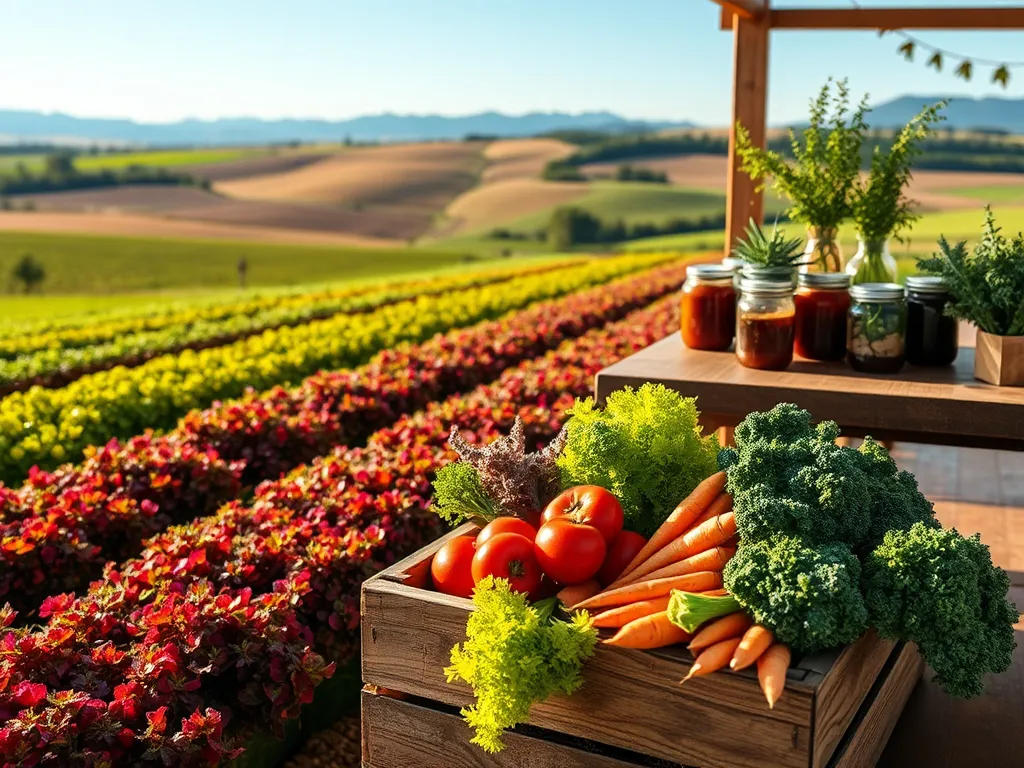From Farm to Table: Alberta's Seasonal Produce Insights

Exploring Seasonal Produce in Alberta
Seasonal produce in Alberta plays a vital role in the region's agriculture, offering both flavors and a connection to local farming practices. This province, with its diverse climate, supports the growth of a variety of fruits and vegetables throughout the year. Eating seasonally not only enhances the taste of our meals but also supports local economies and reduces environmental impact. From the refreshing crops of spring to the hearty harvests of fall and the resilience of winter produce, Alberta's seasonal offerings are a testament to nature's bounty.
Spring in Alberta marks the awakening of the growing season. As the snow melts and the days grow longer, farmers and gardeners alike begin to cultivate fresh greens and early vegetables. Seasonal produce in Alberta during spring includes vibrant asparagus, sweet peas, tart rhubarb, and a range of locally grown greens. These ingredients are ideal for fresh salads, cozy soups, and sweet desserts, celebrating the vibrant flavors of the season.
As we transition into summer, the bounty of Alberta only expands. From July to September, the warm summer sun ripens tomatoes, berries, sweet corn, and zesty zucchini. These summer harvests are perfect for backyard barbecues, farmers’ markets, and preserving for the colder months. Eating seasonal produce in Alberta during this time encourages creativity in the kitchen, allowing for vibrant salads, delicious jams, and hearty meals that reflect the essence of summer in the province.
Fall ushers in a rich bounty of flavors and feasts as harvest time peaks. Autumn in Alberta is characterized by the gathering of pumpkins, root vegetables, and apples. With shorter days and cooler temperatures, this is the time to enjoy hearty stews, comfort foods, and festive baking. Utilizing seasonal produce in Alberta creates a warm and inviting atmosphere to celebrate the autumn season with family and friends.
During the winter months, while some might think of a scarcity of fresh produce, Alberta offers storage vegetables, greenhouse-grown options, and local grains. These components are crucial for maintaining a nutritious diet despite the cold. Seasonal produce in Alberta during winter may include carrots, potatoes, and various grains, which can be incorporated into wholesome meals to nourish the body through the chilly months. Additionally, tropical fruits sourced from markets provide a refreshing contrast during this season.
Spring Produce in Alberta
One of the first delights of spring is asparagus. Typically harvested from late April through June, asparagus is a versatile vegetable that can be grilled, roasted, or sautéed. Its tender stalks are perfect for adding to omelets or enjoying on their own with a squeeze of lemon. Look for firm, bright green stalks for the best flavor and texture.
Fresh peas are another spring favorite. Alberta farmers grow both snow peas and green peas, which usually reach their peak in late spring. These sweet, crisp vegetables add a delightful crunch to salads and stir-fries. Recipes such as pea and mint soup or a simple sauté with garlic highlight their fresh taste and vibrant green color.
Rhubarb is a spring staple, known for its tart flavor and vibrant red stalks. It is typically available from May to June and is often used in jams, pies, and desserts. Packed with vitamins and minerals, rhubarb is a fantastic source of dietary fiber. When cooking with rhubarb, it pairs well with strawberries for a classic pie or compote.
Local greens, including spinach, kale, and Swiss chard, are also in season during spring. These leafy vegetables offer a wealth of nutrients, including vitamins A, C, and K. They can be used in salads, smoothies, or lightly sautéed as a side dish. Combining a variety of greens can provide a colorful and healthful addition to any meal.
Summer Harvests in Alberta
Summer is synonymous with juicy tomatoes, which thrive in Alberta’s sunshine. From cherry tomatoes to beefsteak varieties, the growing season for tomatoes runs from July to September. They are perfect for salads, sandwiches, and salsas. Growing tips include ensuring they receive plenty of sunlight and consistent watering for the best yields.
Sweet corn is another beloved summer crop, celebrated for its peak season in August. Fresh corn on the cob is a staple at summer barbecues. Roasting, grilling, or boiling brings out its natural sweetness, while recipes like corn chowder or corn fritters add variety to meal planning.
Berries are plentiful in summer, with strawberries, blueberries, raspberries, and saskatoon berries available for picking from June through August. These delicious fruits can be enjoyed fresh, in smoothies, or preserved through jams and freezing. Picking guides encourage foraging at local farms or markets to experience the freshest flavors.
Zucchini flourishes in the warmth of summer, with its peak season from July to September. This versatile vegetable can be spiralized into noodles, grilled, or baked into breads and muffins. Tips for storage include keeping them in the refrigerator to maintain freshness and using them in various dishes throughout the summer months.
Fall Bounty in Alberta
Fall is a time for pumpkins, with harvest season typically from September to November. These vibrant squashes are not only great for decoration but can also be used in soups, pies, and roasted dishes. Recipes often highlight pumpkin’s natural sweetness in both savory and sweet preparations.
Root vegetables such as carrots, beets, and potatoes are plentiful in the fall. These hearty crops can be stored throughout the winter months in cool, dark locations. Roasting, mashing, or using in stews are excellent methods for enjoying their rich flavors.
Apples come into season in late summer and peak in early fall. Varieties such as Honeycrisp, Granny Smith, and Cortland thrive in Alberta’s orchards. They are perfect for snacking, baking into pies, or making cider. Recipes that incorporate apples often celebrate the season with spiced flavors.
Cranberries have a short harvest time in mid-fall. These tart berries add a burst of flavor to various dishes and are commonly used in sauces, jams, and desserts. Their bright color and tangy taste make them a popular addition to holiday feasts.
Winter Produce in Alberta
Winter produce in Alberta primarily consists of storage vegetables like carrots, squash, and onions. These vegetables are essential for a balanced diet, providing essential nutrients and versatility in cooking. They can be stored for months, making them key ingredients in hearty winter recipes.
Greenhouse options allow for the availability of fresh greens even in winter months. Local greenhouses provide a selection of salad greens, herbs, and even tomatoes. These indoor farming practices contribute to reducing the gap left by seasonal limitations.
Local grains, including barley, wheat, and oats, play an essential role in sustaining Alberta's economy and diet. They offer significant health benefits, such as fiber, vitamins, and minerals, important for maintaining a balanced diet.
In addition to local produce, tropical fruits can be sourced from specialty markets during winter months. While not grown locally, these fruits offer a refreshing option during the colder season, and they can inspire exciting culinary creations.
Culinary Uses for Alberta Produce
Farm-to-table recipes highlight the importance of using seasonal produce in Alberta. Chefs and home cooks alike are inspired to create dishes that showcase the freshness and flavors of locally sourced ingredients. Seasonal highlights include vibrant vegetable salads, delectable fruit tarts, and warm, hearty soups.
Preservation methods such as canning and freezing allow residents to enjoy seasonal produce long after the harvest season is over. Techniques for preserving fruits and vegetables not only help reduce waste but also provide a taste of summer and fall during the winter months.
The nutritional benefits of seasonal eating in Alberta are significant. Consuming produce at its peak ensures maximum freshness, flavor, and nutritional value. Seasonal produce is often richer in vitamins and minerals and supports a balanced diet throughout the year.
Supporting local farmers through seasonal eating promotes sustainable practices. By choosing to purchase local produce, consumers contribute to a healthier environment and a stronger local economy. Being mindful of the seasons creates a deeper connection between food, community, and the land.
